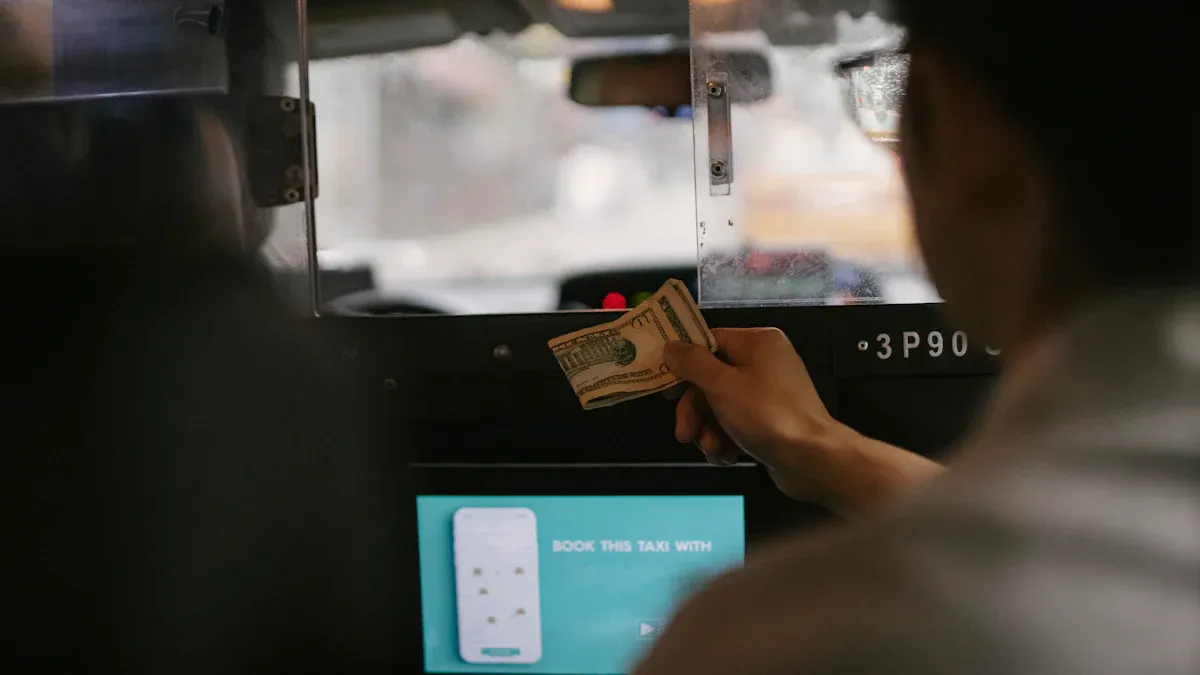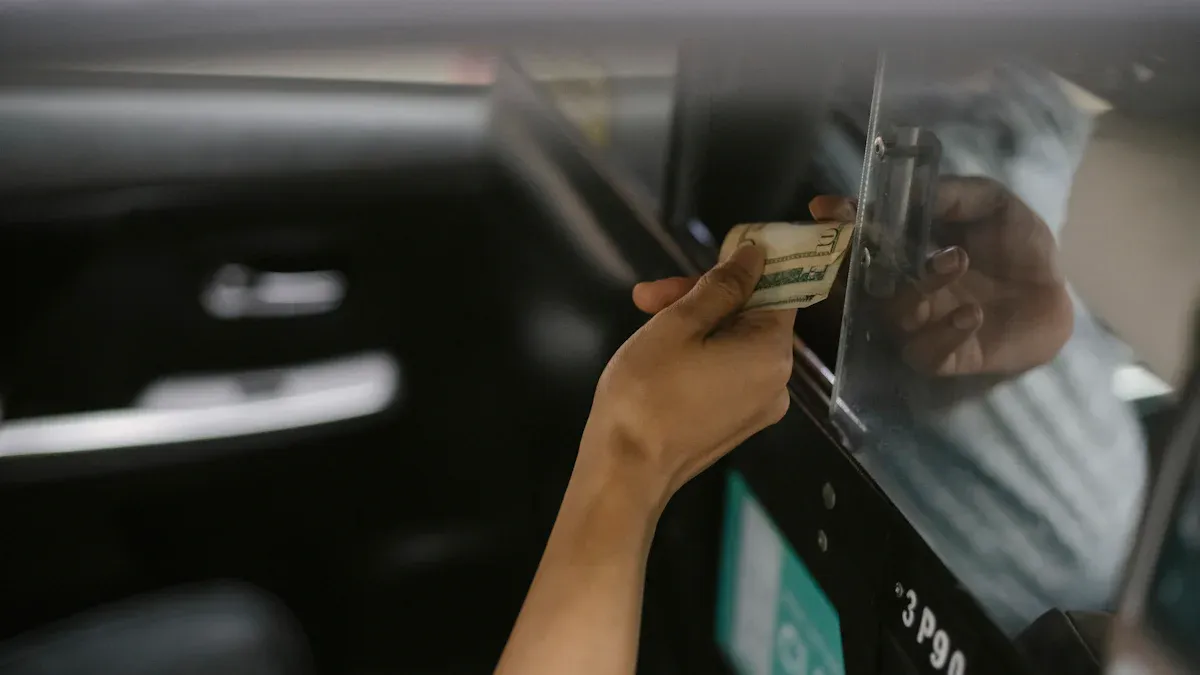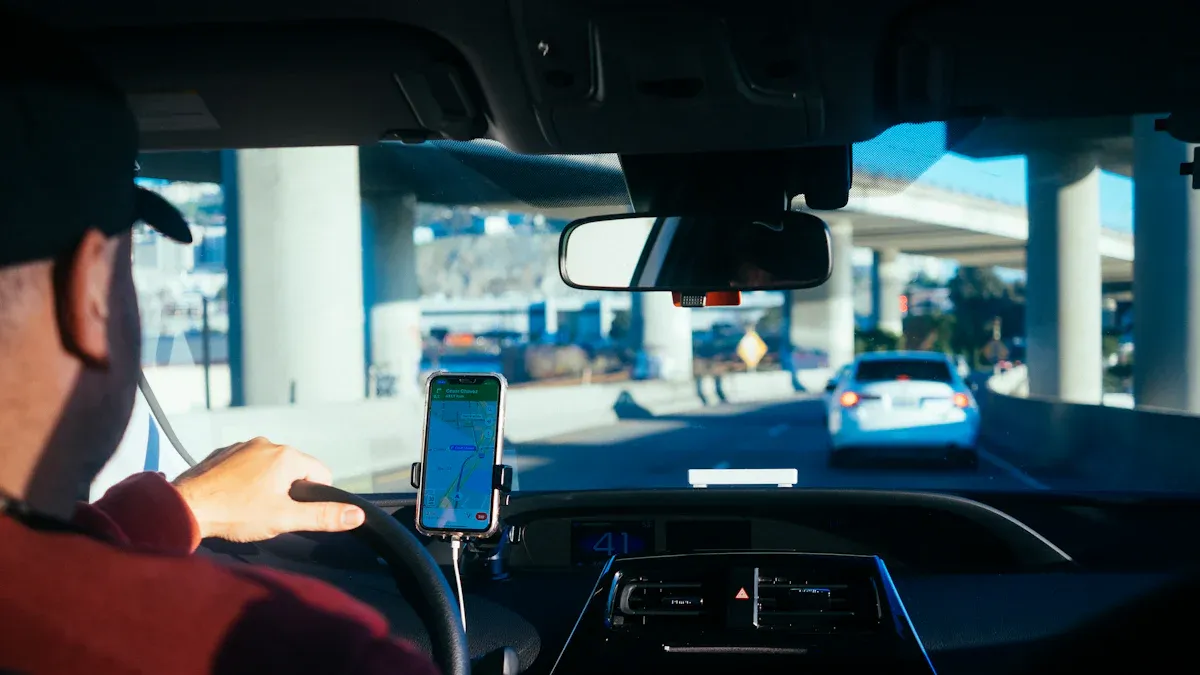
Have you ever gotten into a taxi and seen a bright screen in front of you? That is called a taxi headrest screen. You can watch shows, learn about the city, or play games while you ride. Taxi companies use these screens to make your trip more fun and to show you ads. The screen is at eye level, so you see ads for local stores, events, and brands. This helps taxi drivers make more money, and it lets advertisers reach many people in the city. A taxi headrest screen makes your ride feel modern and interactive.
Key Takeaways
Taxi headrest screens are on the back of front seats. They let you watch videos, play games, and see city guides while you ride. These screens use Android technology. You can touch the screen to control it. They have Wi-Fi, Bluetooth, and GPS. This helps give you new and fun things to do. Taxi companies use these screens to show local ads. The ads match where you are in the city. This helps drivers make more money. You also get deals that can help you. The screens are put in with strong metal brackets. They are made to keep you safe and comfy. Passengers get a fun and modern ride. It is easy to find entertainment and local info. Drivers and advertisers get more money and better ads.
Taxi Headrest Screen Overview

What Is a Taxi Headrest Screen
When you hop into a taxi, you might spot a screen right in front of your seat. That’s a taxi headrest screen. This device sits on the back of the front seat and acts as your personal entertainment center. You can watch movies, play games, or even check out local ads while you ride. The headrest monitor is not just for fun. It also helps drivers and companies show you important information or special offers.
Let’s look at how a headrest monitor compares to other screens you might see in a taxi:
Common Types of Taxi Screens | Description | Typical Sizes (inches) | Key Features and Technologies |
|---|---|---|---|
Rearview Monitors | Used for safety and rear visibility | N/A | Basic display for rear camera feed |
Dashboard Displays | For driver navigation and controls | N/A | Integrated with vehicle systems |
Headrest Screens | For passenger entertainment | 7, 9, 10, 10.1, 10.5, 11.6, 12, 13.3, 14+ | LCD/LED/IPS/4K, touchscreen, Android OS, Bluetooth, Wi-Fi, GPS, voice and gesture control |
A headrest monitor stands out because it mixes entertainment, safety, and advertising in one spot. Unlike other in-car systems, a taxi headrest screen can show you ads, play music, and even help you see what’s behind the car. You get a custom experience with Wi-Fi, USB, and Bluetooth. Some models even let you make hands-free calls.
Where They’re Installed
You will find a headrest monitor right behind the driver’s or front passenger’s seat. This spot puts the screen at eye level, so you don’t have to strain your neck. Most taxis use special brackets or metal cases to keep the taxi headrest screen secure. The screen connects to the car’s power, so it stays on during your whole ride.
Here’s what you might notice about headrest monitors in a taxi:
Most screens range from 7 inches to over 14 inches.
Many run on Android and have touch controls.
You can use Wi-Fi, Bluetooth, or even GPS on some models.
Some headrest monitors support voice commands or gesture control.
You might see ads, games, or city guides on the screen.
Tip: Next time you ride in a taxi, try out the headrest monitor. You might discover a new favorite show or learn something cool about the city!
How Taxi Headrest Screens Work

Technology and Components
When you sit in a taxi, you might notice the headrest monitor right in front of you. This screen uses LCD technology, which gives you a clear and bright picture. LCD screens are the most common choice for these monitors because they work well in different lighting conditions. You can see the display clearly, even on a sunny day.
Most headrest monitors run on the Android operating system. This makes the screen easy for you to use. You can tap the touch screen to pick a movie, play a game, or check out local ads. The Android system also lets the headrest monitor connect to Wi-Fi, 4G, Bluetooth, and GPS. This means you get real-time updates, location-based ads, and even video calls if the taxi offers that feature.
Some headrest monitors have motion sensors. When you get into the taxi, the screen can turn on by itself. The monitor might also have a camera for video calls or QR code scanning. You can control the volume and turn the screen on or off. The headrest monitor is built with safety in mind. It uses a strong metal bracket to stay in place, and it has anti-theft features to keep it secure.
Tip: If you want to adjust the screen, just use the touch controls. The Android system makes it simple for anyone to use.
Installation Process
You might wonder how the headrest monitor gets into the taxi. The process is pretty simple. First, the installer attaches the monitor to the headrest poles using a metal bracket. This keeps the screen steady, even when the taxi goes over bumps. Some taxis use a fixed bracket, while others use a method that sticks the monitor in place.
The installer connects the headrest monitor to the car’s power system. This way, the screen turns on when the taxi starts. Safety is very important during installation. The monitor must not block the driver’s view or make the ride less comfortable for you. The screen size usually stays between 7 and 9 inches, so it fits well and does not get in the way.
Here’s a quick look at the steps:
Attach the monitor to the headrest poles with a metal bracket.
Secure the bracket to make sure the monitor does not move.
Connect the monitor to the taxi’s power supply.
Check that the monitor does not block any views or make the seat uncomfortable.
Make sure you can control the screen and volume.
Note: Only you, the passenger, should use the headrest monitor while the taxi is moving. The driver cannot operate it for safety reasons.
Content Delivery
The headrest monitor in your taxi does more than just play videos. It connects to the internet using 4G or Wi-Fi. This connection lets the taxi company send new ads, games, or city guides right to your screen. The company uses a cloud-based system to manage all the content. They can update the headrest monitor from anywhere, so you always see fresh information.
When you ride in a taxi, the monitor might show you ads for local shops or events happening nearby. The system can even change the ads based on where the taxi is. If you are near a popular restaurant, you might see a special offer pop up on your headrest monitor. The content updates quickly and does not need anyone to touch the monitor in the taxi.
You get a smooth experience because the monitor uses the latest technology to deliver content. The Android system, fast internet, and smart software all work together to make your ride more enjoyable.
Headrest Monitor Features
Entertainment Options
When you ride in a taxi, the headrest monitor gives you lots of ways to have fun. You can watch videos, listen to music, or look at pictures from your seat. The screen plays movies in MP4, songs in MP3, and photos in JPG. You might find games or city guides to check out. Some taxis let you play quizzes or see news updates. This makes the headrest monitor fun for both short and long rides. If you like in-car entertainment, you will enjoy these screens.
Interactivity
You do more than just watch the headrest monitor. You can interact with it. The screen has a 5-point touch display. You can tap, swipe, and pick what you want. The Android system lets you choose your favorite things or play games with a touch. You might see ads that change with your location because of GPS. Some screens show QR codes you can scan for deals or rewards. Here are some interactive things you might see: Touch controls for easy use, ads and info that change with your location, games and quizzes to play, QR codes for rewards or payments, and updates that keep things new.
Tip: Try tapping the headrest monitor next time. You might find a new game or a special deal just for you!
Connectivity
The headrest monitor connects to the internet with Wi-Fi, 4G, or a SIM card. This means you always get new content, like movies or city guides. Some headrest monitors work with apps like Uber and Lyft. You see ads and offers that match your trip. The screen can connect to your phone with Bluetooth. This makes it easy to share music or pay with your phone. Taxi companies use cloud software to manage what you see. The headrest monitor always feels up to date.
Power-saving features help the headrest monitor use less energy. Many screens have motion sensors. The display turns on when you sit down and off when you leave. Here’s a quick look at how different sensors save power:
Motion Sensor Type | Detection Method | Energy-saving Impact |
|---|---|---|
Passive Infrared (PIR) | Detects body heat via infrared | Turns screen on when you are there, off when you leave, so the screen is not used too much. |
Ultrasonic | High-frequency sound waves | Finds people by sound, turns screen on only when needed. |
Dual-technology | PIR + ultrasonic | Makes sure the screen is on only when someone is there, saving energy. |
Capacitive | Detects proximity | Turns the screen on when you are close, stops extra screen time. |
Radar | Electromagnetic waves | Sees movement, turns screen on or off to save power. |
Photoelectric | Light beam interruption | Notices motion by a broken light beam, turns screen on or off to save power. |
The headrest monitor keeps your ride smart, connected, and saves energy.
Taxi Headrest Advertising Screens
Targeted Advertising
When you ride in a taxi, you are part of a group that cannot leave. Taxi headrest advertising screens use this by showing ads that match where you are and where you are going. These screens use Android tablets with 4G internet. The taxi company puts a special app on each screen. This app knows the taxi’s location and the route you take. It can show ads for a restaurant nearby or a store you will pass soon.
Taxi headrest advertising screens do more than just play random ads. They use a back office system to manage all the ads. This system tracks which ads get the most attention and changes what you see using real-time data. You might notice the ads feel more personal and timely. That is because the system uses analytics to make sure the ads fit you and your trip.
You see ads that matter to you, and advertisers reach people who are likely to watch during the ride.
Taxi headrest advertising screens give brands a new way to reach people in the city. The taxi company also gets extra money for every ad shown. As a passenger, you get local deals and information right when you need them.
Legal Compliance
Taxi headrest advertising screens must follow strict rules, especially in big cities like New York. The city wants to keep ads balanced with passenger comfort and safety. Not every car can use these screens for ads. Here is a quick look at how New York City handles ads on taxi headrest advertising screens:
Aspect | Details |
|---|---|
Governing Authority | New York City Taxi and Limousine Commission (TLC) |
Taxi TV Advertising | Allowed on taxi headrest advertising screens in yellow taxis to help pay for required technology |
Advertising in For-Hire Vehicles (FHVs) | Not allowed on headrest screens in FHVs unless the TLC gives special permission |
Enforcement | TLC can fine drivers $50 for breaking the rules |
Passenger Feedback | Many riders dislike too much advertising, so the TLC sometimes tests removing ads |
Court Rulings | Courts have supported the TLC’s right to limit advertising in FHVs |
Taxi headrest advertising screens must follow these laws. If you see ads in a taxi, the company has met the city’s rules. The rules help protect you as a passenger and make sure ads do not ruin your ride.
Benefits
For Passengers
When you ride in a taxi with a headrest screen, your trip feels more fun and comfortable. You can watch videos, play games, or check out local news. The screen gives you something to do, so you do not get bored. You might see city guides or maps that help you learn about new places. If you like shopping or eating out, you will notice special deals and offers from advertising right on the screen.
You get local information fast.
You can find new restaurants or stores through advertising.
You stay entertained during your ride.
You see important updates about your route or city events.
Tip: Try using the touch screen to explore city guides or find a cool event. You might discover something new before you reach your stop!
For Drivers
Headrest screens help you as a driver in many ways. The advertising on these screens brings in extra money, which can boost your income. You do not have to do anything special—the system works on its own. The screens also remind passengers to leave good ratings and tips. Many drivers say these reminders help them get more 5-star reviews and bigger tips. The screens show clear messages about no smoking, eating, or drinking, so your car stays clean and fresh.
You earn more from advertising without extra work.
Passengers see reminders to rate and tip you.
Your car stays cleaner with clear rules on the screen.
You get better reviews, which can lead to more rides.
Many drivers notice that passengers appreciate the clean car and friendly reminders. This makes your job easier and your day better.
For Advertisers
If you want to reach people in the city, taxi headrest screens are a smart choice. You can show your advertising to riders who sit and watch during their trip. The screens let you target your advertising by location, time, or even the type of passenger. You can update your advertising quickly, so your message always feels fresh. This way, your advertising reaches people when they are most likely to pay attention.
Advertising Benefit | How It Helps You |
|---|---|
Targeted advertising | Shows ads to the right people |
Real-time updates | Keeps your advertising current |
High visibility | Riders see your advertising up close |
Local focus | Promotes city events and businesses |
Taxi headrest screens make your advertising more powerful. You reach people at the perfect moment—while they travel and look for things to do.
Taxi headrest screens make taxi rides more fun and interesting.
You can watch shows, see deals, and get updates on the screen.
Drivers make extra money from ads, and advertisers show you special messages.
These screens use smart tools like GPS and AI to show ads that match you.
The screens are built in parts and have strong internet, so ads stay new and work well.
You can play games, read news, and see ads that fit your trip.
Companies can change ads from far away to keep them helpful.
The screens are bright and clear, so ads look good and are easy to see.
Local stores use ads to tell you about deals and events.
As cities get bigger, ads on taxi headrest screens will change how you travel and see the city.
Next time you ride in a taxi, look at the headrest screen. You might find ads that make your trip more fun and help you feel connected.
FAQ
What can you do on a taxi headrest screen?
You can watch videos, play games, check out city guides, and see ads for local deals. Some screens let you listen to music or read news. Just tap the screen to explore.
Is it safe to use the headrest screen during your ride?
Yes! The screen sits securely on the seat. You control it with a touch. Drivers cannot use it while driving, so you stay safe and focused on your ride.
Can you turn off the screen if you do not want to watch?
Yes, you can! Most screens have a power or mute button. If you want a quiet ride, just tap the controls to turn off the sound or the display.
Do taxi headrest screens collect your personal data?
No, the screens do not collect your name or contact info. They might use your location to show local ads, but your personal details stay private.
See Also
Audi CarPlay Screens Inspired by Tesla Compared by Features
Best Five E90 CarPlay Screens Suitable for Every Budget
Reviewing Leading Motorcycle GPS Units Featuring CarPlay And Android
CarPlay Options Explored For BMW F30 Infiniti And Universal
Comparing Top CarPlay Dongles That Support Netflix Streaming
